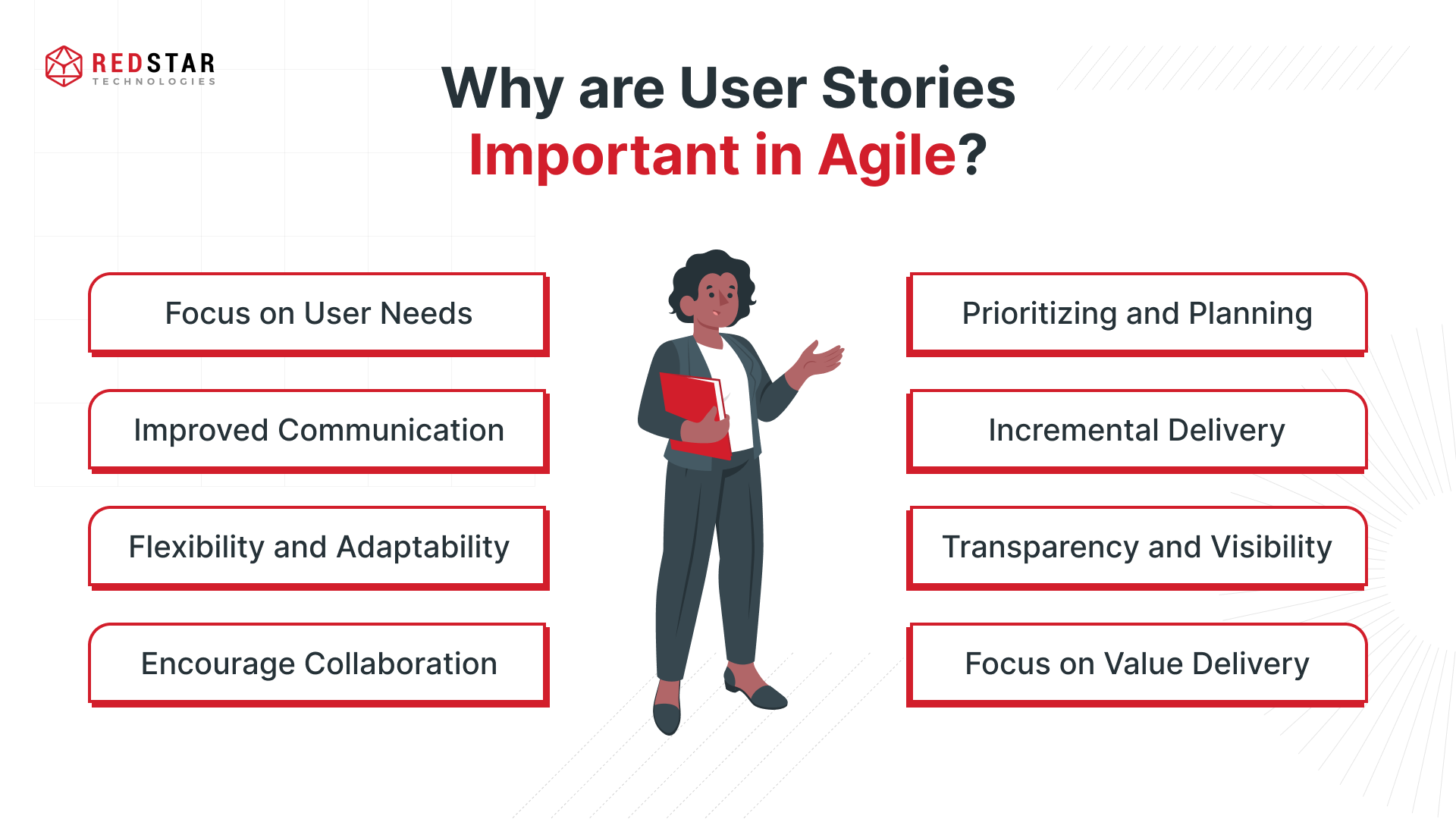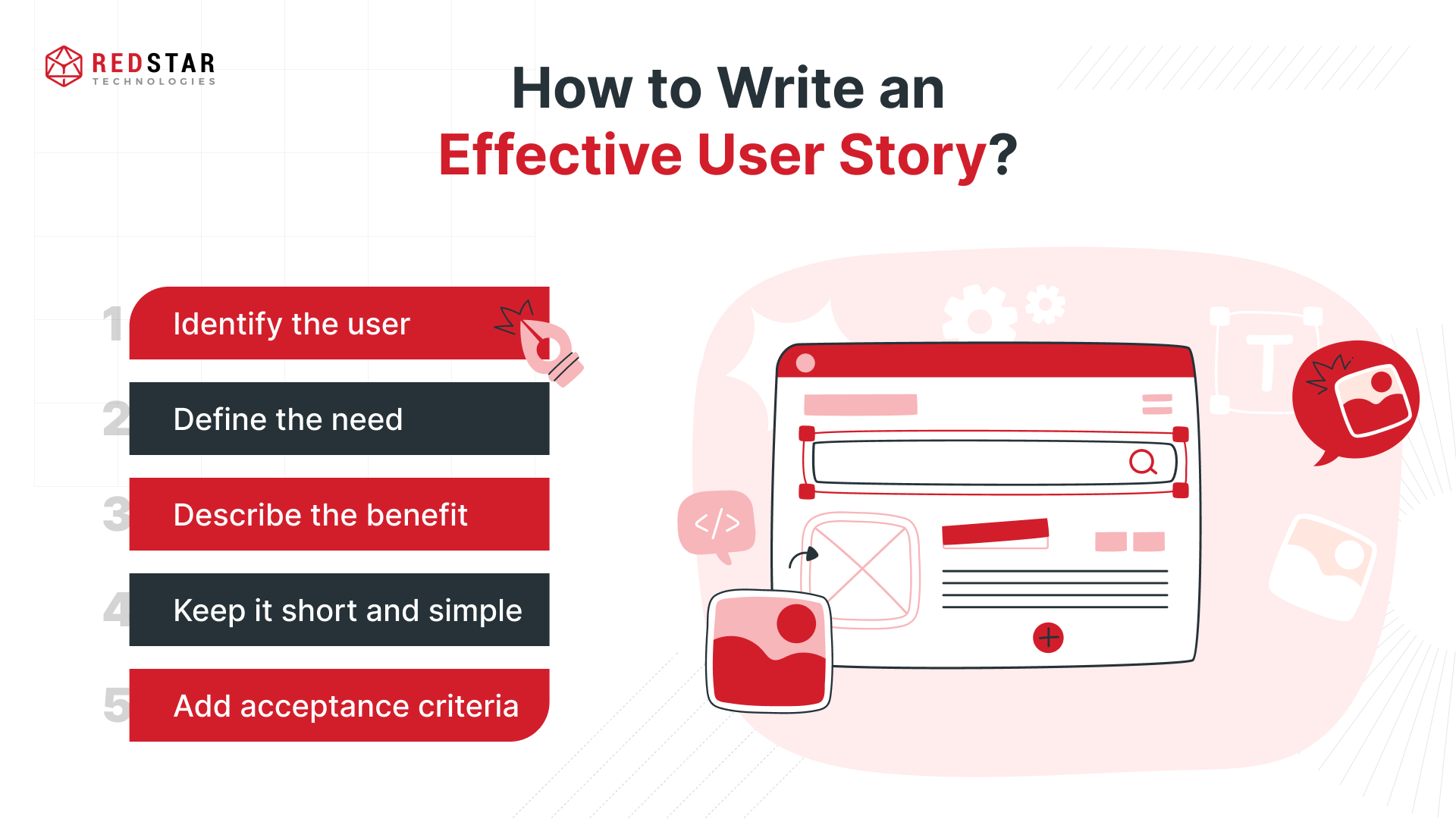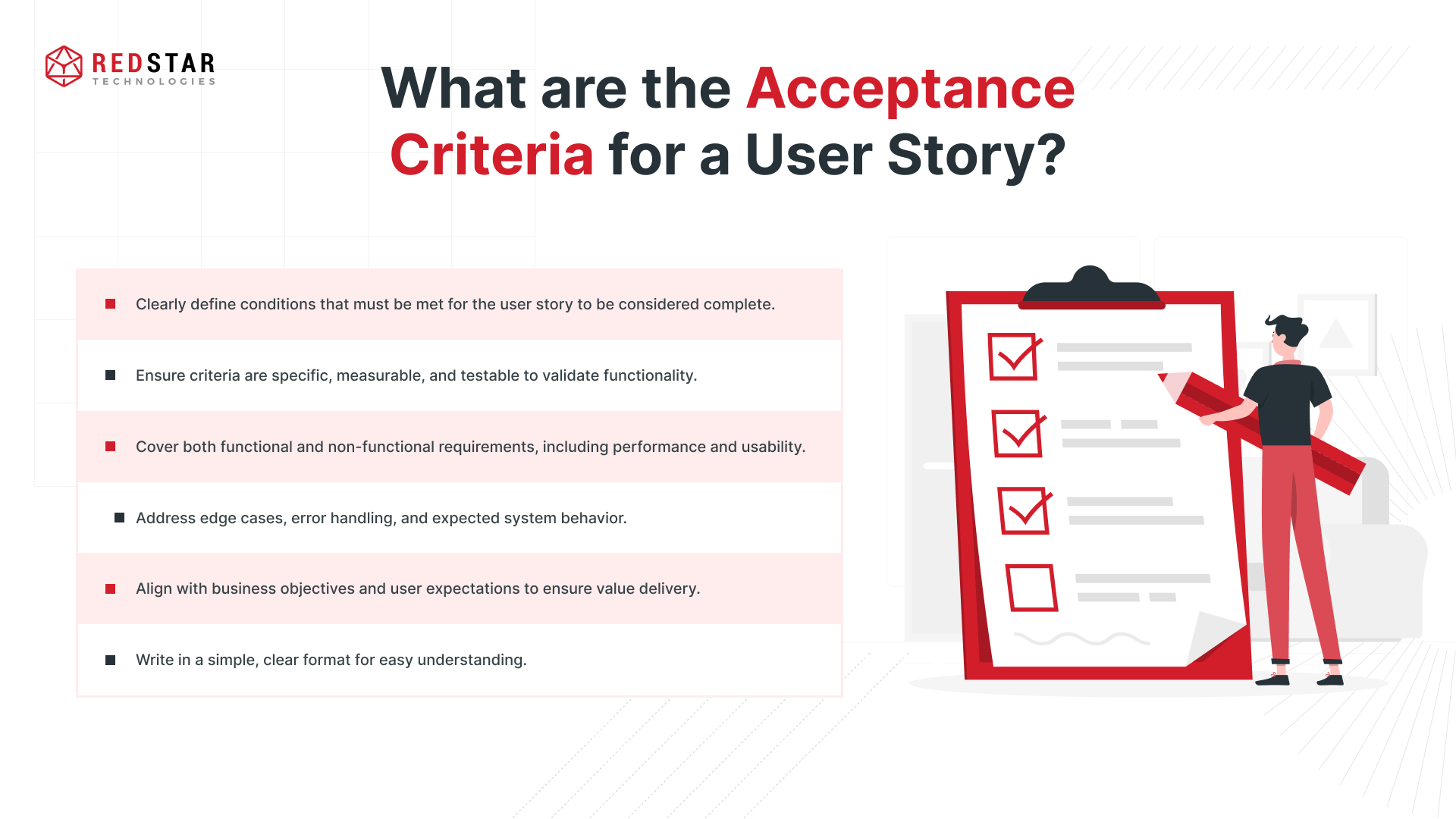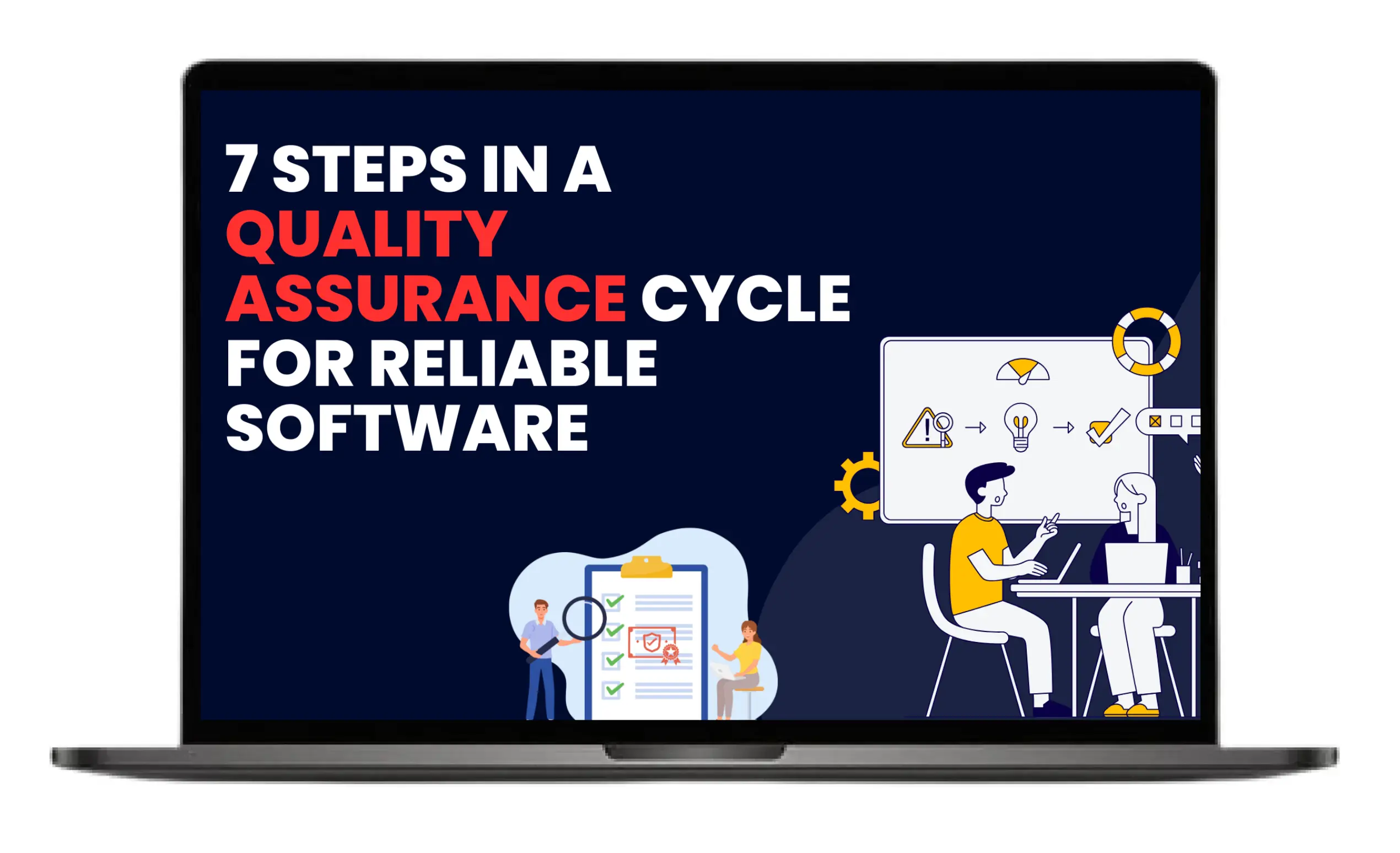
Sometimes products are built without gathering enough information about the true audience. By audience we mean, for whom it is built and what they need from it. Companies write piles of pages as requirements. Unfortunately, they still miss the mark. Why? Absence of user stories. User stories change the overall dynamic of how the Agile teams think, plan, and deliver software.
Agile development focuses on delivering value quickly and efficiently. A user story is a simple tool that helps teams understand the user's needs. It ensures that development aligns with user expectations and business goals.
What is a User Story?
To be clear, user stories are not like the stories or tales we used to hear from our elders. There is no moral at the end. Just focused on project and product management goals. So, what actually is a user story?
A user story is a short, simple description of a feature or functionality. Written from the perspective of the end user, the user story outlines what the user wants to achieve and why it matters. Results? It helps Agile teams focus on delivering value rather than just completing tasks.
Key Elements of the User Story
User stories differ from traditional requirement documents not only in format but also in how they convey information.
- User stories are short
- They are written from the end user perspective.
- They are iterative and are easy to evolve.
- They serve as a reminder for future conversations
- Independent- It should stand alone and not depend on other stories.
- Negotiable- Open to discussion and changes.
- Valuable- Provides clear value to the user.
- Estimable- The team should be able to estimate the effort required.
- Testable- There should be a way to verify if it’s done correctly.
Common Formats of User Stories
Like every story that has a plot, characters and an end, the user story also has the format to follow. As they are short and written from the end user perspective, user stories ensure clarity by defining who needs them.
“As a [type of user],
I want [an action or goal],
so that [a reason or benefit].
For example,
“ As a Facebook user, I want to reset my login credentials so that I can use the application in my spare time”
Purpose And Benefits of a User Story
When it comes to Agile environments, user stories play a very important role
- As mentioned earlier, user stories are written from the end user perspective. That is why every user story clearly defines why it is built and directly ties to the user’s goals.
- Not all stakeholders are tech-savvy. A language fathomable to all creates a huge difference. So, user stories bridge the gap and simplify communication between stakeholders.
- With the help of user stories, teams can prioritize and deliver small, valuable units of work quickly and effectively.
Creating and Managing User Stories User story mapping
User stories are most effective when organized and refined as part of an Agile process. Management has a lot to say in it. It ensures that stories are not just stories but align with user needs and business priorities.
User Story Mapping
It is an important step in creating a user story. Story mapping analyses how the user interacts with the product. Say you are using FaceBook. The development team monitors user interactions with the software at every step.
This helps them have a better understanding of complex journeys into manageable steps.
Story Splitting Techniques
Know that some stories are large and vague in nature. They need to be split down. For that, common splitting techniques are followed. These include:
- Workflow steps: Split by different stages of the user’s interaction
- Data variations: Handle different inputs or edge cases separately
- Business rules: Separate logic-heavy parts from basic functionality
- CRUD operations: Divide by create, read, update, delete actions
- Happy path vs. exceptions: First build the ideal scenario, then add variations
Prioritization and Grooming
Maintaining clarity is key to writing effective user stories. So, creating stories is just a means and not an end. The product owner and team regularly visit the story and refine it accordingly.
For instance, they evaluate the story relevance and update the acceptance criteria. Regular grooming ensures that the product backlog stays clean, actionable, and aligned with strategy.
Why are User Stories Important in Agile?
User stories differ from traditional requirement documents not only in format but also in how they convey information.

1. Focus on User Needs
User stories are written from the perspective of the end user, ensuring that the development team prioritizes delivering value to the customer. This keeps the focus on solving real user problems rather than just building features.
2. Improved Communication
User stories provide a simple, clear, and concise way to communicate requirements between stakeholders, product owners, and development teams. They avoid technical language, making them accessible to non-technical stakeholders.
3. Flexibility and Adaptability
User stories are lightweight and easy to modify, which aligns with Agile’s iterative and incremental approach. They allow teams to adapt to changing requirements or new insights without significant overhead.
4. Encourage Collaboration
User stories foster collaboration between team members and stakeholders. They often serve as a starting point for discussion, helping clarify requirements, identify potential challenges, and brainstorm solutions.
5. Prioritizing and Planning
User stories help teams prioritize work based on user value. They are often written in a format that includes acceptance criteria, making it easier to estimate effort and plan sprints or iterations effectively.
6. Incremental Delivery
User stories are small and focused, enabling teams to deliver working software incrementally. This allows for frequent feedback and ensures that the product evolves in alignment with user needs.
7. Transparency and Visibility
User stories provide transparency into what is being developed and why. They are often displayed on Agile boards (e.g. Scrum or Kanban boards), giving everyone visibility into the progress and priorities.
8. Focus on Value Delivery
By breaking down features into user stories, a team can deliver small, valuable increments of functionality in each iteration. This ensures continuous delivery of value to users.
Common Challenges in Writing User Stories and How to Overcome Them
No doubt, user stories are short. The shorter the text, the lesser the chances of problems. Still, teams often face multiple challenges while writing a user story. Let’s have a look at those challenges:
Vague or Ambiguous Stories
Some user stories are not clear in themselves. Either the end goal is missing or the user intent is not in place. As a result, it creates confusion for the development teams.
Solution:
The best way is to write a user story as clearly as possible. It must explain what the user want to do and what his ultimate goal is. Be it proper compliance with the format or adding context and acceptance criteria, these initiatives help craft a clear and understandable user story.
Overly Technical or Solution-Oriented Wording
We all know that not everyone is tech-savvy. We have to Google everything technical we read. When user stories are written in technical jargons, they hardly serve the purpose of gaining the user value.
Solution:
The goal should be to explain what the user wants and not how it will be built, the product. Leaving implementation details to technical discussions during sprint planning can be another solution to this challenge.
Stories That Are Too Large
Since user stories are short and handy, writing them in large captions is a problem in itself. The epics result in complexity and confusion. This is so because oversized stories are really hard to test and estimate within a sprint.
Solution:
One way is to break down the large stories into small and independent chunks. Doing this ensures clarity and avoids confusion on the end user’s part.
Missing or Incomplete Acceptance Criteria
Without clear acceptance criteria, teams may finish a story without knowing if it actually meets expectations.
Solution:
Define acceptance criteria alongside the story, during backlog grooming or refinement.
Prioritization Confusion
Stories may not align with business value.
Solution:
Use prioritization methods like MoSCoW (a prioritization technique used in project management to categorize requirements into Must-have, Should-have, Could-have, and Won’t Have to ensure sufficient resources) to focus on high-value features.
Key Characteristics of a Well-Written User Story
A good user story should be:
- Independent- It should stand alone and not depend on other stories.
- Negotiable- Open to discussion and changes.
- Valuable- Provides clear value to the user.
- Estimable- The team should be able to estimate the effort required.
- Small- Should be small enough to complete within one iteration.
- Testable- There should be a way to verify if it’s done correctly.
How to Write an Effective User Story?
To write a good user story, you need to follow these steps:

- Identify the user: Understand who will use the feature.
- Define the need: What problem does this feature solve?
- Describe the benefit: Why is this important for the user?
- Keep it short and simple: Avoid complex or technical terms.
- Add acceptance criteria: Define conditions that must be met for the story to be considered complete.
User Stories vs. Other Agile Concepts
- User Stories vs. User Cases: User cases are detailed and cover different scenarios, while user stories are short and focused.
- User Stories vs. Epic: Epics are large stories that can be broken down into smaller user stories.
- User Stories vs. Tasks: Tasks are specific steps needed to complete a user story.
Common Challenges in Writing User Stories and How to Overcome Them

1. Vague or Unclear Requirements
- Challenges: Stories may lack detail, causing confusion.
- Solution: Use the INVEST criteria and add clear acceptance criteria to ensure clarity and shared understanding.
2. Overly Complex or Large Stories
- Challenges: Large stories are hard to estimate and complete in one iteration.
- Solutions: Break them into smaller, focused stories using techniques like story splitting.
3. Lack of User Focus
- Challenges: Stories may focus on technical details instead of user needs.
- Solutions: Write from the user’s perspective.
4. Poor Prioritization
- Challenges: Stories may not align with business value.
- Solution: Use prioritization methods like MoSCoW (a prioritization technique used in project management to categorize requirements into Must-have, Should-have, Could-have, and Won’t Have to ensure sufficient resources) to focus on high-value features
5. Insufficient Acceptance Criteria
- Challenges: Without clear criteria, it’s hard to know when a story is done.
- Solution: Define specific, testable acceptance criteria for each story.
6. Overloading Stories with Details
- Challenges: Too much detail can make stories grid.
- Solution: Keep stories high-level and negotiable, allowing flexibility during development.
7. Lack of Collaboration
- Challenges: Stories written in isolation may miss key insights.
- Solution: Involve the team and stakeholders in refinement sessions or workouts.
8. Ignoring Non-Functional Requirements
- Challenges: Stories often overlook performance, security, or usability.
- Solutions: Include non-functional needs as separate stories or in acceptance criteria.
Best Practices for Writing User Stories in Agile
- Keep them short and focused.
- Use simple, user-friendly language.
- Collaborate with stakeholders.
- Regularly refine and update stories.
- Always include acceptance criteria.
Who Writes User Stories?
The product owner primarily leads story creation. However, all teams play a critical supporting role. Remember, effective story creation involves collaboration between multiple roles to ensure clarity, feasibility, and business value. So, here are key stakeholders that are involved in story creation.
- Product Owner: The Primary Author
- Development Team: Co-creators and Refiners
- Stakeholders and Customers
- Scrum Master or Agile Coach (optional participant)
- Collaborative Process
What are the Acceptance Criteria for a User Story?
Acceptance criteria are specific conditions that must be met for the story to be considered complete. They provide clarity and ensure the features work as intended. The following are the acceptance criteria for a user story:

- Clearly define conditions that must be met for the user story to be considered complete.
- Ensure criteria are specific, measurable, and testable to validate functionality.
- Cover both functional and non-functional requirements, including performance and usability.
- Address edge cases, error handling, and expected system behavior.
- Align with business objectives and user expectations to ensure value delivery.
- Write in a simple, clear format for easy understanding.
What Happens if a User Story is Too Large?
Large user stories (epics) are broken down into smaller, more manageable stories through techniques like story splitting or focusing on specific user tasks.
Can User Stories Include Technical Tasks?
While stories focus on user needs, technical tasks can be created as sub-tasks or linked to the story to ensure implementation details are addressed.
Conclusion
User stories are a simple but powerful tool in Agile. They help teams build features that users need while keeping the process flexible. Writing clear, well-structured user stories improves collaboration and ensures better product outcomes.



















